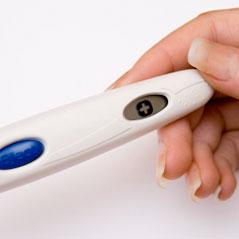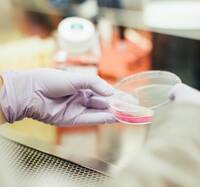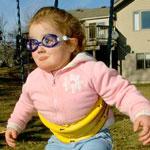PBA201H: The Biology of Prenatal Human Development
Video (15min cut of EHD documentary): http://media.trtl.ca/tablet/ehd_med.m4v
When does human life begin?
Fertilization
- As we learned in PBA100Y, a new human being comes into existence at Fertilization.
“This brand new embryo contains the original copy of a new individual’s complete genetic code. Gender, eye color, and other traits are determined at conception, also known as fertilization.”1)
- How does sperm-egg fusion occur?
- A mature egg will leave the ovary and the sperm that travels through the Fallopian tube will fuse with the egg; the first sperm that fuses, uses the enzymes to crack through the outer layer (zona pellucida) of the egg and fuse with the inner membrane; then, there's an outer barrier created that will prevent any other sperm from fusing with that egg.
It is generally better to use the term “fertilization” when discussing human development. “Conception” is a more vague term because it may refer to either fertilization or implantation, depending on the speaker. 
- Four Principles: At fertilization, a unique, whole, living human being comes into existence.
- Unique:
- The genetic code of the zygote is unique–distinct from those of the mother and father. For instance, a pregnant woman could be pregnant with a male child.
- Whole:
- Some may ask what makes a single-celled zygote different from a single cell of, say, human skin. Both are living, human, diploid cells. However, one is a human whole while the other is a human part. Give each cell time, nutrition, and safety, then wait 9 months or 15 years…which one continues developing into a toddler, or a teenager? A skin cell will always remain a skin cell, while a zygote will continue human development into an embryo, fetus, newborn, toddler, etc.
- Nothing is added to the embryo from the time of fertilization except adequate nutrition and a proper environment, which is what we need now. Since nothing essential has been added, and you’re a whole organism now, then you must have been that same whole organism at fertilization.
- Living:
- If something is growing, isn't it alive?
- We know from the law of biogenesis that living things come from other living things. After all, if the pre-born child isn't biologically alive, why would a woman need an abortion?
- Human:
- If someone has human parents, aren't they human offspring?
- Cellular Biology: Composition and Behaviour
- While the zygote is a very young individual composed of only one cell, that one cell is substantively different from the sperm cell or egg cell. We can see this by considering the criteria science uses to distinguish between different cell types: cell composition and behavior. In other words, what the cell is made up of, and what it does.
- Composition: Whereas a sperm is composed of 23 chromosomes from the father and an egg is composed of 23 chromosomes from the mother, a zygote is composed of both. Sperm and egg, i.e. gametes, are haploid; the zygote is diploid. (
include technical language of haploid vs. diploid?)
- Behaviour: And where the behavior of sperm and egg is to penetrate or be penetrated (respectively), the zygote’s behavior is to do neither. The zygote acts in a coordinated manner for the health of the whole, and she self-directs her own growth. And so, the zygote is fundamentally different from sperm or egg. No human can claim ever having been a sperm or an egg, but as Drs. Moore and Persaud explain, the formation of the zygote 'marks the beginning of each of us as a unique individual.'
Let's set aside for a moment the question of abortion, of whether or not it destroys a human life. Let's instead look at when we want to create a new human life. Imagine that a fertility specialist2) wants to create a new human life in a lab, outside of normal sexual reproduction. What process would she replicate?
Would she do in-vitro…implantation? In-vitro…heartbeat at 3 weeks? Would she try to replicate the moment of brain activity beginning? No, she would do in-vitro fertilization3). The fusion of sperm and egg is what is required to create a new human being. A fertility specialist will not be satisfied with a sperm sample or egg sample, but will be satisfied with a single-celled zygote. We know when life begins when we want to create life–it's when we want to destroy a human life that we suddenly become confused.
Think about it: Pregnancy is typically 9 months long. 9 months starting when? At fertilization!
Developmental Milestones
Developmental Timeline
have Oriyana or other staffer look over this for accuracy, or check against this / pull significant points from EHD Prenatal Summary http://www.ehd.org/prenatal-summary.php
- The first eight weeks of a pre-born child's life are referred to as the embryonic period, and the child may be called an embryo during this time. The period from nine weeks until birth is referred to as the fetal period, and the child may be called a fetus during this time.
- The embryonic period is a time of rapid growth and development for the child:
“Most significant developmental milestones occur long before birth during the first eight weeks following conception when most body parts and all body systems appear and begin to function. The main divisions of the body, such as the head, chest, abdomen and pelvis, and arms and legs are established by about four weeks after conception. Eight weeks after conception, except for the small size, the developing human’s overall appearance and many internal structures closely resemble the newborn.” 4)
- Within the embryonic period, there are further subdivisions depending on the embryo's age.
- At fertilization, the single-celled embryo is called a zygote (Greek for “yoked”, since sperm and egg have fused together).
- By day 3, the embryo is spherically-shaped and consists of 12 to 16 cells. She's called a morula (Latin for “mulberry”, which is what she resembles!).
- Between 4 and 5 days after fertilization, the embryo is called a blastocyst and she has a hollow space in the centre. Her inner layer of cells will divide and differentiate into her various tissues and organs, while the outer layer of cells will form the placenta and extra-embryonic tissues.
Implantation

- Implantation starts at the end of the first week after fertilization, and is complete at about two weeks5). Some argue that this is where life begins. But implantation simply marks a change of location (from fallopian tube to uterus), rather than a change of nature. The human being prior to implantation is the same as the human being after implantation (just like before and after birth—another event marking a location change).

- Admittedly, most pregnancy tests will only read positive after implantation; as a result, abortion advocates tend to argue that women only become pregnant after implantation. In fact, they’ve even redefined the word “conception” to mean implantation, arguing that’s when pregnancy begins.
- But the fact that a pregnancy test doesn’t come back positive pre-implantation doesn’t mean life isn’t there—it just means the test's ability to detect that life isn’t there.
- Take, for example, the commonly used hCG pregnancy test, one which looks for Human Chorionic Gonadotropin in a woman’s urine. hCG is a hormone that is secreted by the developing placenta, and this occurs at implantation.
- The release of hCG indicates the presence of the pre-born child, but it doesn’t mean she didn’t exist prior to that. We know this intuitively, of course: Just imagine you enter your home and find a stray puppy hiding in your bedroom—but you only discover it after you’ve been home for 30 minutes. Clearly, the puppy did not enter your house when you first discovered it, but instead when it managed to crawl in.
- Likewise, one’s offspring first exists at fertilization even if we don’t discover her existence until implantation.
Primitive Streak & Twinning
- At approximatly 14 days after fertilization6), the primitve streak will form in the embryo.
- Before this point, it is possible for identical twinning to occur, as some embryos can split into two before the formation of the critical streak. This rare phenomenon is often raised to dispute the idea that life begins at fertilization. Instead, some argue, it exists at the point of twinning, or after the point where twinning can occur7).
- Just because some humans have the ability to split into two, doesn’t mean that prior to the split one human didn’t exist.
- Take the case of the flatworm.8) If a flatworm is cut in half, each half will regenerate into two separate, fully-functioning flatworms. But prior to this separation a flatworm nonetheless existed.
- Likewise, even though in rare situations one human splits into two, one human existed before that split happened, and the beginning of that one human was still at fertilization.
ERI Video on this: https://www.instagram.com/reel/C0Rw2iorBaA/?utm_source=ig_web_copy_link
Heartbeat
Embed video in actual CCBR website (can embed EHD videos w/o permission): <iframe src=“http://www.ehd.org/widget2.php?movie=1&title=1&age=1” width=“330” height=“426” frameborder=“0” scrolling=“no”><a href=“http://www.ehd.org/widget2.php?movie=1&title=1&age=1”>Play Movie</a></iframe>
Brain
- A pre-born child's brain waves have been detected by an electroencephalogram (EEG) at as early as 6 weeks and 2 days.12)
An abortion advocate may argue that a pre-born child is not a living human being until she has detectable brain activity. How do we know that pre-born children are still human beings, even before brain activity begins?
 Imagine that in one petri dish is an amoeba, a single-celled organism, and in another petri dish is the single-celled human zygote. They are both living, single-celled organisms. Given time, nutrition, and safety, will the amoeba ever have brain activity? No–because of what it is–an amoeba. It is not in the nature of an amoeba to develop a brain. In contrast, if the zygote is given time, nutrition, and safety, will she ever have brain activity? Yes. Why? Because of what she is: a human being. Why does she not have brain activity yet? Because of how old she is. She is too young to yet develop that function. Discriminating against her for a developmental feature that is directly reflected in her age would be age-based discrimination.
Imagine that in one petri dish is an amoeba, a single-celled organism, and in another petri dish is the single-celled human zygote. They are both living, single-celled organisms. Given time, nutrition, and safety, will the amoeba ever have brain activity? No–because of what it is–an amoeba. It is not in the nature of an amoeba to develop a brain. In contrast, if the zygote is given time, nutrition, and safety, will she ever have brain activity? Yes. Why? Because of what she is: a human being. Why does she not have brain activity yet? Because of how old she is. She is too young to yet develop that function. Discriminating against her for a developmental feature that is directly reflected in her age would be age-based discrimination.
Pain
- Determining precisely when the pre-born feel pain is largely dependent on technology to detect this. While it is an interesting topic, it has no bearing on the morality of abortion. After all, is it wrong to kill someone because she feels pain or because she’s human?
- Consider Gabby Gingras, an American girl with a rare condition called hereditary sensory autonomic neuropathy, Type 513). In short, she cannot feel pain. As a baby, she poked and scratched her eyes, causing significant damage—she never felt pain to tell her to stop.
- May we kill her because of her inability to feel pain? Why then may we kill the pre-born because they don't feel pain at certain points during pregnancy?
- To make the point even more simply: would it be permissible to kill a 3-year-old boy as long as we give him anaesthetic first?

Viability
- The term “viability” refers to a pre-born child's ability to survive–to be viable–outside of the womb.
“By 21 to 22 weeks after fertilization, the lungs gain some ability to breathe air. This is considered the age of viability because survival outside the womb becomes possible for some fetuses.”14)
- Some will argue that a human being's life doesn't begin until viability, when the child can survive independent of her mother's body. However, viability does not mark a change in the child's humanity–merely a change in the child's dependence. This greater dependence is again due to the child's age.
- Furthermore, the age of viability is becoming earlier and earlier because of advancements in medical care for premature babies. For instance, only a few decades ago in the 1970s, a 25-week-old child would not be viable outside the womb, but a child of that age could survive outside the womb today. Would a 25-week-old fetus in the 1970s therefore not be a human being with human rights?
- Lastly, a pre-born child is always viable if in the right environment. We would not expect an adult human to survive unprotected on another planet, because that is not a safe environment for that human. Similarly, a pre-born child will survive and grow if she is in the proper environment for someone her age–the womb.
confusing viability and vitality, the difference between being able to survive and being alive
Common Objections
“A fetus is just a blob of tissue, just a clump of cells.”
- Terms like “blob of tissue”, “clump of cells” etc. are dehumanizing terms that are ultimately meaningless. It's true that a pre-born child is a “clump of cells” – but so is a born human being! A group of skin cells or blood cells would be an example of human parts, while a pre-born child is a human whole–an individual organism with coordinated functioning.
- Although a pre-born child is less developed than older humans, she is still a human being with human rights, regardless of her developmental level.
“It doesn't even look like a human being.”
- Pre-born children also look different from born children; a zygote looks different from a 10-week-old fetus, who looks different from a toddler, etc.
- But how would we expect a human being of that specific age to look? For instance, we would not expect a toddler to undergo the same body changes that a teenager undergoes during puberty. Pre-born children look exactly the way they are supposed to look for their age and level of development.
- Richard Stith offers the following analogy15): Consider a Polaroid picture. Once you click the camera and the card comes out, what initially appears is brown/black smudges. But within a few minutes the image appears with clarity. The image is captured in an instant but it does need time to develop. So it is with each of us—who we are as unique, unrepeatable individuals is captured in an instant (fertilization); we just need time to develop.
“So many embryos miscarry anyway, so what's the big deal about abortion?”
- Some abortion advocates point out that the rate of miscarriage is high in the first trimester of pregnancy, and some women miscarry without ever knowing that they were pregnant. They argue that this is evidence that pre-born children have little significance, and abortion is therefore an action of little significance.
- It is true that some children die naturally, through miscarriage. However, how would this fact justify abortion? If some children tragically die naturally during pregnancy, how would this make it permissible to kill other children intentionally? The causes of death are different in each scenario.
- As an analogy, if one person dies of a heart attack, would that make it permissible to kill another person by stabbing him in the heart?
“A fetus isn’t human, it’s just a parasite feeding off of a woman’s body!”
- While a fetus does require nutrients from her mother via the umbilical cord in order to survive, it is unscientific to call the fetus a parasite. By definition, a parasite must be of a different species than the host organism–for example, a flea on a dog. Since a fetus and her mother are of the same species – the human species – it doesn’t make sense to call her a parasite.
“An embryo is basically a tumour feeding off the mother's body.”
- Some will compare a pre-born child to a tumour, since both are growing groups of cells.
- A tumour occurs when cells from a person's own body begin to proliferate (divide) as an uncontrollable pathology. The cells will have the same DNA as the diagnosed individual, proving that those are cells of the individual.
- The human embryo, in contrast, has her own unique genetic code that differs from that of her mother. The cells of her body will proliferate in a controlled, coordinated manner (leading to the various developmental milestones listed above).
- Ultimately, this is an anti-science comparison that we can know intuitively to be untrue. If you have one friend who has just gotten a positive pregnancy test, while another friend has just tested positive for cancer of the uterus, which of those two friends will give birth in nine months?
Conclusion
Biology textbooks, embryology studies, and medical advancements continue to confirm what we already know: pre-born children are living human beings from fertilization onward. By advocating for the legal protection of the pre-born, pro-lifers are simply advocating for science-based public policy.
Other Links
Embryology presentation used by CCBR
- From Oriyana Hrycyshyn (can sub in name of any child for her sister Inessa)
- approx. 45 min, covers all the major milestones of prenatal development + leaves time for questions/practice
- Link to Google Doc of notes: https://docs.google.com/document/d/16o1oh6ClzosIVa1SHByPgNXtNkTKHv1m8rrZteoxnno/edit?usp=sharing
- https://prolifetraining.com/resources/five-minute-10/ | constructed vs developing
 terminology?
terminology?

